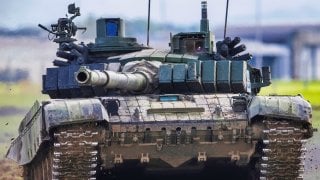Russia’s Military: What Comes After the Ukraine War?
Through the 2025-2027 budget, Putin is trying to demonstrate to Russian citizens that the military is in it for the long haul. He will now have to prove that he is capable of suppressing the undesirable side effects that come with decreasing investments in non-military sectors and not having the requisite infrastructure to care for soldiers returning from the front.
Positing what Russia’s postwar army will look like is a dangerous game, for a variety of variables will influence its trajectory.
Earlier this month, Russian President Vladimir Putin signed a decree increasing the size of the Russian Armed Forces by 180,000 soldiers. This suggests that Moscow is operating on the assumption that the conflict will persevere beyond the next few months. In parallel, the Russian government has introduced a three-year budget that will increase its military spending to historic highs from 2025-2027.
The Kremlin has determined that defense spending must overshadow funding to civic programs. On the educational front, Vladimir Medinsky, assistant to the president of the Russian Federation, recently called the eleven years that Russian students spend in secondary school an “unaffordable luxury” harkening back to the nineteenth century. Meanwhile, the Russian Ministry of Science and Higher Education is adding entrance exams to make it more difficult for students to attend universities. The 2025-2027 budget outlines $1 trillion for the modernization of Russia’s healthcare system over the next six years, a number which loses its shine when placed beside the $1.7 trillion allocated from 2019-2024.
However, cuts in the new budget go beyond the civil sector. Calculating that the price of an oil barrel will decrease from $69.70 in 2025 to $65.50 in 2027, the Russian government is predicting 27 percent less revenue from its oil and gas reserves. It also anticipates that the ruble will weaken compared to the dollar. Tax hikes and inflation will accompany cuts in most sectors, excluding defense, to ensure that the budget deficit does not exceed 1 percent of GDP.
In short, Moscow has made defense its top priority in the three coming years, attempting to do so in a way that does not dramatically shake civil society. Taking inspiration from Mikhail Kutuzov’s Scythian plan against Napoleon, whereby Russian citizens were prepared to accept short-term sacrifices for their welfare to beat back an incursion into their territory, the Russian army is not scrambling to rapidly expel Ukrainian soldiers from the Kursk oblast. Putin appears to have assessed that it is in Russia’s interest to pivot to a long-term wartime footing that may involve oscillations in his fortune in the coming years.
This strategy rests on the indifference of average Russian citizens regarding events on the front, which is only possible if they do not have the impression that they are living in a wartime economy. Accordingly, at least 10,000 migrants have been sent to the front, usually in exchange for Russian citizenship. Felons hoping to avoid sentences are taking up arms to earn conditional releases. Past mobilizations have included significant loopholes to appease an uncertain population.
With this in mind, the Kremlin will likely continue cautiously growing the size of the army regardless of whether peace is signed with Ukraine in the next few months. The budget foresees a reduction in defense spending in 2026 and 2027, hinting that Putin considers 2025 to be a decisive year in re-establishing the army’s resources and capabilities. To further mitigate blowback at the local level, the president is writing off regions’ debts, proceeding slowly with mobilization, and conducting meticulous evacuations of targeted Russian territories.
Russia’s army will thus likely revert to its prewar size when the Kremlin determines that its objectives are fulfilled. Alongside Ukraine, it will have undergone countless leadership reorganizations while acquiring technical training and drone warfare experience. Troops and residents alike will probably remain frustrated at senior officials misleading the president and accepting bribes, but neither of these problems is new in Russian history. Putin likely envisions the upcoming surges in the defense budget as a way to recover from the army’s losses throughout the past few years as he digs into a protracted struggle for Ukraine’s eastern territory.
Perhaps more interesting than the army itself will be the trickling social problems that follow the Defense Ministry’s recruitment strategy. Traumatized veterans bringing violence into heretofore undisturbed urban centers, State Duma bills to end the criminal prosecution of criminals turned soldiers, and the forced enlistment of migrant workers may bode poorly for Russian civil society. Through the 2025-2027 budget, Putin is trying to demonstrate to Russian citizens that the military is in it for the long haul. He will now have to prove that he is capable of suppressing the undesirable side effects that come with decreasing investments in non-military sectors and not having the requisite infrastructure to care for soldiers returning from the front.
About the Author
Axel de Vernou is a senior at Yale University majoring in Global Affairs and History with a Certificate of Advanced Language Study in Russian. He is a Research Assistant at the Yorktown Institute.
Image Credit: Creative Commons and/or Shutterstock.


